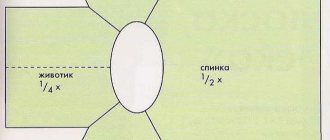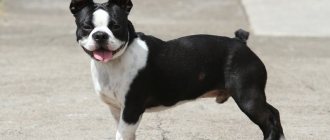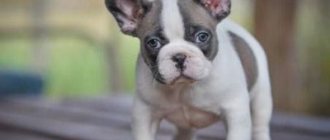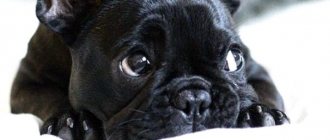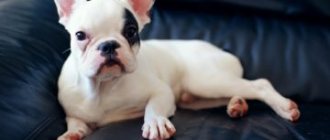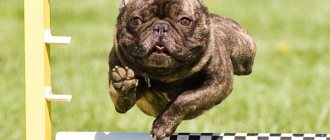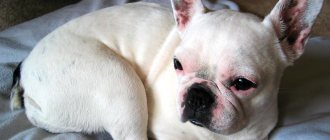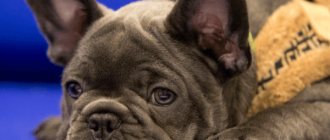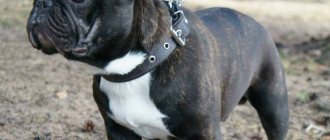Sweater with Norwegian pattern
Sizes: XS; S; M; L.
Chest circumference: 28-32; 40-44; 50-54; 60-66cm
Back length: 24-26; 32-34; 40-42; 48-52cm.
We will need:
- h/w yarn (50g per 100m), coffee color – 50; 100; 150; 200g; *same, white – 50; 50; 100; 100g; *same, chocolate color – 50; 50; 50; 100g; *set of toe knitting needles No. 3.5 – for size XS; *set of toe knitting needles No.3;
- circular knitting needles No. 3.
Patterns:
- persons Ch.: when knitting in the round, all sts in all rows are knitted, when knitting forward/reverse, we alternate r. persons p. with a row of purl;
- elastic band: 2l.x2i.
Patterns of the Norwegian pattern for knitting a sweater for a dog - see below.
Density: facial. Ch. 22p. for 30r. equal to 10 cm by 10 cm.
Description
Let's start knitting a sweater for a dog using sock knitting needles. We dial on sp. No3 coffee yarn 52; 76; 100; 124p. and knit in a round cut for 6; 8; 10; 12cm. Let's go to sp. No3.5 and knitting faces. Ch. In the first row of this pattern we add 8 stitches. at regular intervals. We get 60 in work; 84; 108; 132p. Next, for knitting, we use the Norwegian pattern patterns in the specified sequence:
- for solution XS: A-1; A-2; A-4;
- for solution S: A-1; A-2; A-3; A-4;
- for solution M: A-1; A-2; A-3; A-2; A-4;
- for solution L: A-1; A-2; A-3; A-2; A-3; A-4.
Instructions for making increases/decrements:
- when performing the last row of pattern A-1, add 5 at equal intervals; 7; 9; 11p. Total 65; 91; 117; 143p.;
- when performing the last r. scheme A-2 for dits XS and M we subtract 1 p., and for dits S and L we add 1 p. Total 64; 92; 116; 144p.
At height 4; 6; 9; 12 cm from the collar we divide the knitting: closed. 1p., transplant 11; 17; 23; 23p. on aux. sp. (we will knit the belly on these stitches), close. 1 stitch, on the remaining stitches we continue knitting the back according to the patterns. On 10; 14; 18; 22 cm we transfer these points to the auxiliary. knitting needle and return to working on the tummy. We knit it to a height equal to the back. Next, we connect both parts for general circular knitting, while in place of the previously decreased 2 stitches. we dial new 2p.
After completing the patterns, we continue working with coffee thread. At 15; 20; 25; 30cm closed for the tummy average 10; 14; 18; 22p. We continue to knit the back, closing on both sides in each 2 p.: 1; 3; 4; 6 times in 2 p., 9; 8; 9; 8 times 1 p., 1; 3; 4; 6 times in 2 p., 1 time in 3 p. Total 22; 32; 42; 52p. C 29; 38; 47; 52cm from the collar for knitting a sweater for a dog we use sp. No3.
We replant the p. on them and pick up the edges. row of loops. We get 84; 112; 144; 188p. We switch to circular knitting and perform 3; 6; 9; 12 rub. cutting with coffee yarn, 2p. with the same rice and chocolate yarn. Next R. closed P.
For the sleeves, we raise them along the edge of the armholes with knitting needles No. 3 36; 44; 52; 60p. coffee yarn and make 5; 8; 12; 17r. cutting Then we switch to the chocolate thread and knit another 2p. cutting Next R. closed P.
Knitting a sweater for a French bulldog
I promised to share with you another knitting master class for animals. This time we will have knitting not for a small, but for a medium breed - the French bulldog. Dogs of this breed seem to be strong animals only in appearance, but they are painfully tolerant of the cold. I don’t know about this from smart magazines, since I had a Frenchie, but now for about two years he has been living with his mother-in-law, who takes great care of her faithful pet. He endures winters hard because he is spoiled more than usual in cold weather. So the customer decided to insulate her four-legged friend. While there is no snow and frost, you can dress him in a sweater, and then the dog will not refuse a jacket. To knit a sweater for a French bulldog, you need the following materials and tools:
- cherry and pear colored yarn Nako Sport Wool (120m/100g) - knitting needles No. 5 - circular knitting needles No. 4 - knitting needle for joining parts
Yarn composition:
25% wool, 75% acrylic.
This type of yarn is ideal for knitting items for athletes and dogs, as the products are quite warm and keep their shape well for a long time. They do not fade and stretch even after frequent washing. To start knitting, you need to cast on 72 stitches using pear-colored thread. We knit 6 cm with a 1x1 elastic band. After the elastic, change the color of the yarn and knit 1 row with facial loops. We divide the knitting into two parts: 26 loops (tummy) and 46 loops (back). We knit the belly
row 2 - purl all, plus a yarn over after each loop (26 26 loops) Row 3 - we knit the knit stitches with the knit stitches, and the yarn overs - with the purl rows 4-25 rows (11 cm) - we knit an elastic band 1x1 Row 26 (wrong side) - cast off 6 loops at the beginning of the row 27 row - close 6 loops at the beginning of the row 28-43 rows (6 cm) knit an elastic band 1x1 Row 44 - add 6 loops at the beginning of the knitting row (yo) 45 row - add 6 loops at the beginning of a row Knit 7 cm with an elastic band 1x1 , after which we divide the knitting into 3 parts (17 loops each). From the middle of the extreme sides, reduce the number of loops by 1 loop every 1 row. When there are 13 loops left on the knitting needle, cut 1 loop in each row. When there are 6 loops left on the knitting needle, knit one out of two loops. We knit the last three loops with one loop.
Knitting the back
We knit 30 cm in garter stitch, after which we begin to cut 2 loops at the beginning of the row every 2 rows. As a result of decreases, 22 loops should remain on the knitting needles (total 36 cm from the collar).
On circular needles No. 4 we hang the back and belly loops and knit with a 1x1 4-5 cm elastic band and pear-colored thread.
Knitting sleeves
We cast on 37 loops on the knitting needles. We knit 1x1 rib for 14 rows, adding 12 stitches evenly. We close the loops. Product assembly
Sew the back and tummy.
We sew the sleeves into rings and sew them to the product.
For beauty, I knitted a bone and sewed it onto the back of the sweater.
This is how the new thing for the French bulldog turned out.
Melange sweater
Dog weight: 12-15kg.
We will need:
- melange yarn, composed of 77% acrylic, 20% wool, 3% polyamide (50g per 70m) – 150g;
- knitting needles No5 and No6.
Patterns:
- cutting: 2l.x2i.;
- persons Ch.: alternate p. persons p. with a row of purl.
Density: face. Ch. 12p. for 19 rub. will be 10cm by 10cm.
Description
Back
Using knitting needles No. 5, cast on 50 stitches. and knit 8p. cutting Let's go to sp. No6 and persons. Ch.
At an altitude of 36 rubles. (19 cm) on both sides we decrease the loops, retreating 2 stitches. from the edge: 2l., 2p. in 1 sheet, faces. to the extreme 4 p., 1 simple broach, 2 l. In 2 rubles repeat the decrease.
On the remaining 46p. let's continue working. Having knitted 58r. (30cm), move on to cutting with knitting needles No. 5. We knit 16 rubles. (this is 8cm) and closed. P.
Tummy
Using knitting needles No. 5, cast on 26 stitches. and do 8 rubles. cutting Let's go to sp. No6 and persons. Ch. From 36r. (19cm) on both sides we decrease by 1 stitch, as described for the back. We repeat the decrease through the row. There are 22 stitches left, on which we knit evenly. From 58r. (30 cm) using knitting needles No. 5, we knit a sweater for a dog using cut knitting. We knit 16 r. (8 cm) and close. P.
Mittens
Sp. No5 dial 26p. and knit 12 rubles in the round. (6cm) cutting. We do not close the loops. We knit the second sleeve in the same way.
Assembly
We sew the upper sections of the cutting. We sew the sleeves with a loop stitch. We make the side seams.
Dressy sweater
Chest circumference: 25.5; 33; 40.5; 61; 76cm.
We will need:
- yarn, 100% acrylic (100g per 176m) – 100; 200; 200; 300; 400g;
- circular knitting needles No. 4 and No. 4.5;
- set of socks No4;
- markers (M).
Conventional abbreviations:
- P3L – cross 3p. to the left: remove 2p. on aux. sp. in front of the canvas, 1l., 2l. with aux. sp.;
- P3P – cross 3p. to the right: remove 1 p. on aux. sp. behind the canvas, 2l., 1l. with aux. sp.; *P4L – cross 4p. to the left: remove 2p. on aux. sp. in front of the canvas, 2l., 2l. with aux. sp.;
- P4P – cross 4p. to the right: remove 2p. on aux. sp. behind the canvas, 2l., 2l. with aux. sp.;
- P5P - cross 5p. to the right: remove 3p. on aux. sp. behind the canvas, 2l., 3l. with aux. sp.; *P3iL – cross 3p. from the wrong side to the left: remove 2p. on aux. sp. in front of the canvas, 1i., 2l. with aux. sp.; *P3iP – cross 3p. from the wrong side to the right: remove 1 p. on aux. sp. behind the canvas, 2l., 1i. with aux. sp.
Patterns:
- cutting: 2l.x2i.;
- double pearl pattern: 1p. (front): 1l., *1i., 1l.* – from * to * repeat on all sts; 2p.: 1i., *1l., 1i.* – from * to * repeat on all sts; 3p.: like 1p.; 4p.: like 1p.;
- pattern - diagram A: perform on 8p.: 1p. (fronts): 2l., 4i., 2l.; 2 rub. and all on the wrong side: according to the visible pattern; 3rd: P3L, P3P; 5r.: 8l.; 7r.: P3iL, P3iP; 9r., 11r., 13r.: 2i., 4l., 2i.; 15 rubles: P4P, P4L; 17r.: 8l.; 19 rubles: P3iP, P3iL; 20 rub.: according to risk. These 20 rubles. make up a vertical repeat of pattern A;
- pattern - diagram B: perform on 17p: 1p. (knits.): 5i., P3P, 1i., P3L, 5i.; 2l.: 5l., 3i., 1l., 3i., 5l.; 3r.: 4i., P3P, 1i., 1l., 1i., P3L, 4i.; 4r.: 4l., 3i., 1l., 1i., 1l., 3i., 4l.; 5r.: 3i., P3P, 1i., [1l., 1i.]x2, P3L, 3i.; 6r.: 3l., 3i., 1l., [1i., 1l.]x2, 3i., 3l.; 7r.: 2i., P3P, 1i., [1l., 1i.]x3, P3L, 2i.; 8r.: 2l., 3i., 1l., [1i., 1l.]x3, 3i., 2l.; 9p.: 2p., 2p., 1p., [1p., 1p.]x4, 2p., 2p.; 10r.: 2l., 2i., 1l., [1i., 1l.]x4, 2i., 2l.; 11r.: 2i., P3iL, 1i., [1l., 1i.]x3, P3iL, 2i.; 12r.: 3l., 2i., 1l., [1i., 1l.]x3, 2i., 3l.; 13r.: 3i., P3iL, 1i., [1l., 1i.]x2, P3iL, 3i.; 14r.: 4l., 2i., 1l., [1i., 1l.]x2, 2i., 4l.; 15r.: 4i., P3iL, 1i., 1l., 1i., P3iP, 4i.; 16r.: 5l., 2i., 1l., 1i., 1l., 2i., 5l.; 17r.: 5i., P3iL, 1i., P3iP, 5i.; 18r.: 6l., 2i., 1l., 2i., 6l.; 19r.: 6i., P3iL, 6i.; 20r.: 6l., 5i., 6l. These 20 rubles. form a vertical repeat of pattern B.
Density: on double pearl knot. 19p. for 28 rub. will be 10cm by 10cm.
Description
We start knitting a sweater for a dog with a set of sp. No4 42; 50; 62; 86; 102p. We cut at 7.5; 10; 10; 14; 14cm. In the last row we add 7 stitches at equal intervals. Total 49; 57; 69; 92; 109p. We set M, indicating the end of the river. and go to sp. No4.5. Next, the operating algorithm is as follows:
1r. (fronts): [1l., 1i.]x3; 5; 8; 14; 18 times, 2i., 8p. – сх. A, 17p. – sh.V, 8p. – сх. A, 2i., [1l., 1i.]x3; 5; 8; 14; 18 times. We knit further according to this distribution. At the same time, we knit the loops of the beginning and end of the row with a double pearl pattern, making additions of 1 stitch. in each 3; 5; 5; 9; 5 rubles, then every 2nd rub. before receiving
63; 77; 89; 129; 161p. We include the added items in double pearls. pattern.
From the next R. make slits for the paws: knitting 5; 5; 7; eleven; 12p. pattern, closed track. 4; 6; 6; 10; 12p., 45; 55; 63; 87; 113p. - according to the drawing, next. 4; 6; 6; 10; 12p. close, 5; 5; 7; eleven; 12p. - according to the figure.
Then we knit each part separately at 2.5; 4; 4; 6; 7.5cm height. Last r. - purl Next r. we connect the individual parts into a common fabric: knit 5; 5; 7; eleven; 12p. according to the pattern, over the previously closed points we dial 4; 6; 6; 10; 12p., 45; 55; 63; 87; 113p. – according to the pattern, dial 4; 6; 6; 10; 12p., finish according to the drawing.
It turned out to be 63; 77; 89; 129; 161p. We continue exactly at 11.5; 14; 18; 25.5; 28cm from M, ending purlwise. side by side. At the end of it we put the 2nd M.
At the beginning of the trail. two rubles closed 6; 7; 9; 12; 13p. and we get 51; 63; 71; 105; 135p. We continue according to the figure, making decreases on both sides in even rows. 1 p. before receiving 33; 43; 49; 73; 93p.
Next we knit the dog sweater at exactly 23; 29; 37; 51; 56 cm from the 1st M and transplant the item to the auxiliary. sp.
We make the front seam - from the neck to the 2nd M.
Sp. No4 we dial a circle. knitting needles along the edges of the faces. sides of one side 37; 40; 57; 73; 79p., starting from the 2nd M to the back loops, knit 33; 43; 49; 73; 93 sts of the back with knit stitches. At the same time we perform a decrease of 7p. on the back at equal intervals. Next we raise 37; 40; 57; 73; 79p. on the second side to the row with the 2nd M. There are 100 in total; 116; 156; 212; 244p.
We perform 2.5 cm of elastic bands in a circle. Closed P.
For the paws, we raise 8 along the edges of the openings; 8; 10; 12; 14p. on each side. Total 24; 28; 32; 36; 44p. on one paw. We knit in the round with a cut of 4; 5; 6; 7.5; 7.5 cm. Closed p. For the second paw, repeat as described.
How to knit a sweater for a dog
As an example, let's take a knitted sweater for a French bulldog.
Neck girth 45 cm, chest girth 64 cm, back length (distance from collar to base of tail) 34 cm. Giara yarn (100% wool) ecru 150 g, light denim for pattern approximately 70 - 100 g, knitting needles 2.5 - 3 ,5.
We cast on the loops on circular knitting needles; it is more convenient to make a knitted sweater for a dog using ADDI 60 cm knitting needles.
For the neck - 60 loops, knit with an elastic band 1 x 1 centimeters 7 - 8, in the middle of the elastic for elegance you can knit several rows of blue yarn.
Next, we divide the loops for the raglan: 8 loops for 4 raglan lines (2 loops per line), 9 loops for the sleeves, 16 loops for the back, 18 loops for the front.
Next, we knit in the stockinette stitch in the circle, adding 2 loops in each raglan line every 2nd row.
To make the sweater more voluminous on the chest, you need to knit part of the yoke in incomplete rows, including raglan loops.
Raglan sweater
We will need:
- yarn, consisting of 50% wool, 50% mohair - 50g each of melange and chocolate color;
- set of toe knitting needles No. 3;
- hook No.3;
- markers (M).
Patterns:
- persons Ch.: all loops in all rows. – facial;
- cutting: 2l.x2i.;
- cutting: 1l.x1i.;
- main pattern: 1p.: *2i., 2l. - the algorithm is as follows: we knit the second stitch behind the lower segment, then, without removing it from the sp., we knit the first stitch behind the upper segment, remove both loops, 2i., 3l. we shoot on aux. sp. before knitting, 3l., 3l. with aux. knitting needles* – from * to * repeat on all stitches of the row; 2 rub. (and all even): according to apparent risk; 3r., 5r.: *2i., 2l. (see algorithm for row 1), row 2, row 6* – from * to * repeat on all stitches of the row; 7r.: same as 1r.
Description of knitting a sweater for a dog
Along the length of the product during knitting we alternate color stripes: 2p. one color, 4 rub. – another. We start knitting a sweater with a set of melange yarn 52p. We switch to circular knitting and cut 2l.x2i. by 13cm.
The further distribution of stitches is as follows: 14p. – before, 1p. – raglan line (put M), 7p. – sleeve, 1p. – raglan line (put M), 20p. – back, 1p. – raglan line (put M), 7p. – sleeve, 1p. – raglan line (put M).
We move on to the main pattern, making 1 stitch increments in even rows. on both sides of each M. Having knitted 3 cm, remove the sleeve loops with a pin, and knit the front and back to 10 cm.
Then 18p. from the front side closed The rest - we knit in straight/reverse rows for another 10cm. Then all items are closed. We crochet the edge of the dog sweater with single crochets.
We transfer the sleeve loops to the joint. and knit faces with chocolate yarn. Ch. around by 6 cm, then another 3 cm with an elastic band of 1l.x1i.
Sweater for pet
This master class will help you learn how to knit a beautiful and warm sweater. The most important thing in knitting is to be warm, comfortable and beautiful. You can also use threads from old sweaters and other items. Most often, such items are knitted for small dogs or those whose hair is short.
You can use any thread, but it is important that they are not synthetic, as they can cause discomfort, just like prickly ones.
Before you start knitting this sweater, you must first take the necessary measurements from the dog - the length of the back, belly, chest volume.
Related article: Reducing stitches with knitting needles in a hat with photos and videos
What we need to prepare for knitting:
- the necessary threads of the selected color;
- knitting needles;
- hook;
- measuring tape;
- pattern that we made taking into account the sizes.
Those who are just starting to knit need to knit a test sweater to understand where the mistakes are and how to knit, taking into account the pattern, and we will also be able to determine the knitting density and how the pattern will look on the product. For a dog of the required size, we measure the chest circumference and from these measurements we calculate how many buttonholes we need for the set, in our case approximately 88 buttonholes. We start knitting it from the collar; to calculate it, for a small dog we subtract 20 from 88, and for a medium-sized dog, ten more. Now we collect the required number of buttonholes and knit them with an elastic band one after another, knitting them to a height of four centimeters. And if the dog is larger, then five centimeters of elastic.
The resulting number of buttonholes must be divided into five parts, where we knit the first two parts with an elastic band, the third with satin stitch, and the quarter and fifth with an elastic band. We knit everything like this, only we add loops in every second row to expand the product for the dog’s chest. Approximately after seven centimeters we make holes for the paws. But it's best to try it on. Then we knit again in the same way as before. And so on until the end of the sweater, but we make a reduction so that the sweater does not stretch when worn. At the end we close all the buttonholes. We crochet all the ends and connect the parts. The sweater is ready.
Such sweaters can also be crocheted, then you get a more openwork version, more suitable for a girl than a boy. But in any case, this will keep the dog’s body warm while walking outside.
Related article: DIY glass mosaic for the kitchen and bathroom with photos and videos
